Three PHP extension installation methods under CentOS
Under CentOS, PHP has multiple ways to install extensions, including package management-style yum installation, pecl installation, and source code compilation and installation.
Package management-style installation and uninstallation is particularly convenient, while source code compilation-style installation facilitates parameter tuning.
Generally, package-managed installation is recommended to build a local development environment to save time. For online deployment environments, compilation and installation are recommended to facilitate tuning.
This article uses MongoDB extension installation as an example.
Tools
PHP version: 7.0.17
Nginx: 1.10.2
VMware version number: 12.0.0
CentOS version: 7.0
1. yum installation
The yum method can automatically install the expanded .so dynamic library and configure php.ini
Note:
Please make sure there is a corresponding extension in your yum source
After the installation is complete, restart the server Nginx or Apache
Visit the index.php file with your browser , output phpinfo information, if there is MongoDB information, the installation is successful
[root@localhost ~]# yum search mongodb|grep php # 搜索 yum 源里面 MongoDB 拓展 [root@localhost ~]# yum -y install php70w-pecl-mongo # 安装 PHP 对应版本的 MongoDB 扩展 [root@localhost ~]# systemctl restart nginx # 重新启动 Nginx
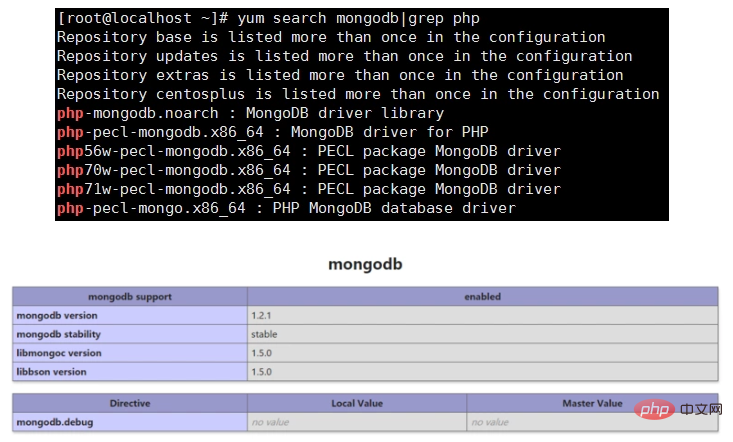
##2. pecl installation
Official documentation: https: //www.php.net/manual/zh/mongodb.installation.pecl.php[root@localhost ~]# pecl install mongodb
[root@localhost ~]# yum -y install php70w-pear [root@localhost ~]# pecl install mongodb configure: error: Cannot find OpenSSL's <evp.h> ERROR: `/var/tmp/mongodb/configure --with-php-config=/usr/bin/php-config' failed
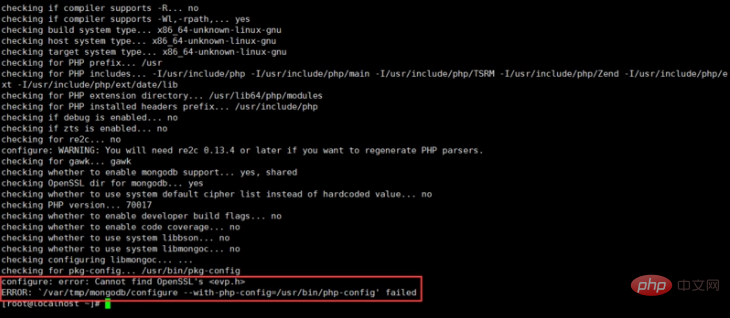
[root@localhost ~]# yum -y install openssl openssl-devel [root@localhost ~]# pecl install mongodb [root@localhost ~]# systemctl restart nginx # 重新启动 Nginx

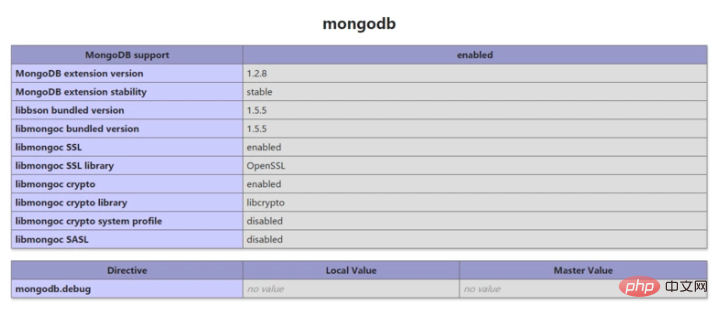
[root@localhost ~]# wget http://pecl.php.net/get/mongodb-1.2.8.tgz #下载源码包 [root@localhost ~]# tar zxf mongodb-1.2.8.tgz #解压 [root@localhost ~]# cd mongodb-1.2.8 # 可能是 /usr/local/php/bin/phpize 找到自己的 phpize 文件,php-config 同理 [root@localhost mongodb-1.2.8]# /usr/bin/phpize Configuring for: PHP Api Version: 20151012 Zend Module Api No: 20151012 Zend Extension Api No: 320151012 [root@localhost mongodb-1.2.8]# ./configure --with-php-config=/usr/bin/php-config configure: error: Cannot find OpenSSL's <evp.h>
##
[root@localhost mongodb-1.2.8]# yum -y install openssl openssl-devel [root@localhost mongodb-1.2.8]# ./configure --with-php-config=/usr/bin/php-config # 确保自己安装了 gcc gcc++ 如果没有安装 yum -y install gcc gcc++ [root@localhost mongodb-1.2.8]# make && make install # 编译
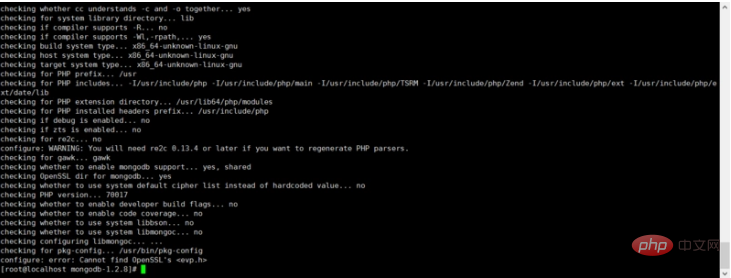 Instructions: php-config is a simple command line Script is used to obtain information about the installed PHP configuration.
Instructions: php-config is a simple command line Script is used to obtain information about the installed PHP configuration. When compiling an extension, if multiple PHP versions are installed, you can use the --with-php-config option during configuration to specify which version to use for compilation. This option specifies the corresponding php-config. The path to the script.
The compilation is successful as shown below
 At this time, load the MongoDB extension in the PHP configuration file php.ini
At this time, load the MongoDB extension in the PHP configuration file php.ini
 Restart the server Nginx or Apache
Restart the server Nginx or Apache
The browser accesses the index.php file and outputs phpinfo information. If there is MongoDB information, the installation is successful
[root@localhost mongodb-1.2.8]# systemctl restart nginx # 重新启动 Nginx
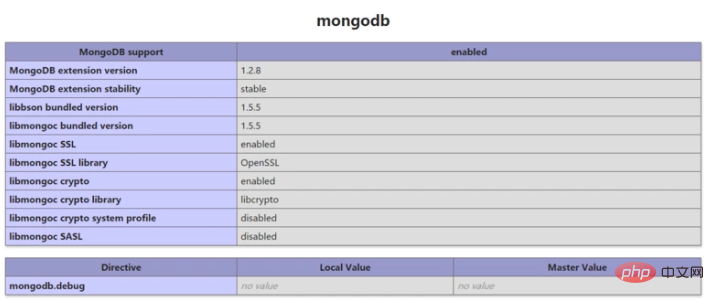
The difference between pecl installation and source code compilation and installation is that the latter is more convenient for parameter tuning.
When choosing Mongo extensions, the official provides two types: mongo and mongodb
The first one: https://pecl.php.net/package/mongo
Second: https://pecl.php.net/package/mongodb
First official tip: This package has been superseded, but is still maintained for bugs and security fixes, has been abandoned, However, bugs and security issues will continue to be fixed, and PHP7 is not supported.
Recommendation:If the PHP version is 5.x, it is recommended to use the mongo extension
The PHP version is 7.x, it is recommended to use the mongodb extension
PHP5.x can use mongodb extension. But PHP7.x cannot use mongo extension.
Written at the end:If you are learning by yourself, it is recommended to install it with yum, because during your installation process, errors will appear for missing various dependencies.
For more PHP related knowledge, please visit
PHP TutorialThe above is the detailed content of Three PHP extension installation methods under CentOS. For more information, please follow other related articles on the PHP Chinese website!

Hot AI Tools

Undresser.AI Undress
AI-powered app for creating realistic nude photos

AI Clothes Remover
Online AI tool for removing clothes from photos.

Undress AI Tool
Undress images for free

Clothoff.io
AI clothes remover

Video Face Swap
Swap faces in any video effortlessly with our completely free AI face swap tool!

Hot Article

Hot Tools

Notepad++7.3.1
Easy-to-use and free code editor

SublimeText3 Chinese version
Chinese version, very easy to use

Zend Studio 13.0.1
Powerful PHP integrated development environment

Dreamweaver CS6
Visual web development tools

SublimeText3 Mac version
God-level code editing software (SublimeText3)

Hot Topics
 1662
1662
 14
14
 1419
1419
 52
52
 1313
1313
 25
25
 1262
1262
 29
29
 1235
1235
 24
24
 How do you parse and process HTML/XML in PHP?
Feb 07, 2025 am 11:57 AM
How do you parse and process HTML/XML in PHP?
Feb 07, 2025 am 11:57 AM
This tutorial demonstrates how to efficiently process XML documents using PHP. XML (eXtensible Markup Language) is a versatile text-based markup language designed for both human readability and machine parsing. It's commonly used for data storage an
 Explain JSON Web Tokens (JWT) and their use case in PHP APIs.
Apr 05, 2025 am 12:04 AM
Explain JSON Web Tokens (JWT) and their use case in PHP APIs.
Apr 05, 2025 am 12:04 AM
JWT is an open standard based on JSON, used to securely transmit information between parties, mainly for identity authentication and information exchange. 1. JWT consists of three parts: Header, Payload and Signature. 2. The working principle of JWT includes three steps: generating JWT, verifying JWT and parsing Payload. 3. When using JWT for authentication in PHP, JWT can be generated and verified, and user role and permission information can be included in advanced usage. 4. Common errors include signature verification failure, token expiration, and payload oversized. Debugging skills include using debugging tools and logging. 5. Performance optimization and best practices include using appropriate signature algorithms, setting validity periods reasonably,
 Explain late static binding in PHP (static::).
Apr 03, 2025 am 12:04 AM
Explain late static binding in PHP (static::).
Apr 03, 2025 am 12:04 AM
Static binding (static::) implements late static binding (LSB) in PHP, allowing calling classes to be referenced in static contexts rather than defining classes. 1) The parsing process is performed at runtime, 2) Look up the call class in the inheritance relationship, 3) It may bring performance overhead.
 PHP Program to Count Vowels in a String
Feb 07, 2025 pm 12:12 PM
PHP Program to Count Vowels in a String
Feb 07, 2025 pm 12:12 PM
A string is a sequence of characters, including letters, numbers, and symbols. This tutorial will learn how to calculate the number of vowels in a given string in PHP using different methods. The vowels in English are a, e, i, o, u, and they can be uppercase or lowercase. What is a vowel? Vowels are alphabetic characters that represent a specific pronunciation. There are five vowels in English, including uppercase and lowercase: a, e, i, o, u Example 1 Input: String = "Tutorialspoint" Output: 6 explain The vowels in the string "Tutorialspoint" are u, o, i, a, o, i. There are 6 yuan in total
 What are PHP magic methods (__construct, __destruct, __call, __get, __set, etc.) and provide use cases?
Apr 03, 2025 am 12:03 AM
What are PHP magic methods (__construct, __destruct, __call, __get, __set, etc.) and provide use cases?
Apr 03, 2025 am 12:03 AM
What are the magic methods of PHP? PHP's magic methods include: 1.\_\_construct, used to initialize objects; 2.\_\_destruct, used to clean up resources; 3.\_\_call, handle non-existent method calls; 4.\_\_get, implement dynamic attribute access; 5.\_\_set, implement dynamic attribute settings. These methods are automatically called in certain situations, improving code flexibility and efficiency.
 PHP and Python: Comparing Two Popular Programming Languages
Apr 14, 2025 am 12:13 AM
PHP and Python: Comparing Two Popular Programming Languages
Apr 14, 2025 am 12:13 AM
PHP and Python each have their own advantages, and choose according to project requirements. 1.PHP is suitable for web development, especially for rapid development and maintenance of websites. 2. Python is suitable for data science, machine learning and artificial intelligence, with concise syntax and suitable for beginners.
 PHP in Action: Real-World Examples and Applications
Apr 14, 2025 am 12:19 AM
PHP in Action: Real-World Examples and Applications
Apr 14, 2025 am 12:19 AM
PHP is widely used in e-commerce, content management systems and API development. 1) E-commerce: used for shopping cart function and payment processing. 2) Content management system: used for dynamic content generation and user management. 3) API development: used for RESTful API development and API security. Through performance optimization and best practices, the efficiency and maintainability of PHP applications are improved.
 PHP: A Key Language for Web Development
Apr 13, 2025 am 12:08 AM
PHP: A Key Language for Web Development
Apr 13, 2025 am 12:08 AM
PHP is a scripting language widely used on the server side, especially suitable for web development. 1.PHP can embed HTML, process HTTP requests and responses, and supports a variety of databases. 2.PHP is used to generate dynamic web content, process form data, access databases, etc., with strong community support and open source resources. 3. PHP is an interpreted language, and the execution process includes lexical analysis, grammatical analysis, compilation and execution. 4.PHP can be combined with MySQL for advanced applications such as user registration systems. 5. When debugging PHP, you can use functions such as error_reporting() and var_dump(). 6. Optimize PHP code to use caching mechanisms, optimize database queries and use built-in functions. 7




